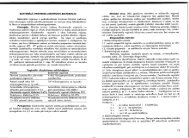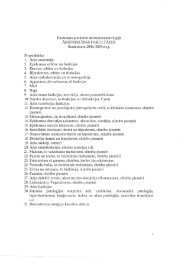PHYSICS
n - susliks.lv
n - susliks.lv
- No tags were found...
Create successful ePaper yourself
Turn your PDF publications into a flip-book with our unique Google optimized e-Paper software.
organs on the head below and in front of the eyes, which are<br />
extremely sensitive thermoreceptors. Each pit is a cavity about 5<br />
mm deep. The sensitivity of the snake to rapid changes of<br />
temperature is 0.002°C. The pit organs also act as a directional<br />
distance receptor.<br />
Fish. Many species of bony fish (teleosts) are sensitive to very<br />
small changes of water temperature - from 0.03°C to 0.07°C.<br />
Practically the entire surface of the fish, including the fins, is<br />
thermosensitive. Likewise, elasmobranchs, such as rays and<br />
sharks, have distinctive sense organs, called ampullae of Lorenzini,<br />
that are highly sensitive to cooling.<br />
lOS<br />
14.4. EFFECTS OF TEMPERATURE ON PLANTS<br />
Plants can survive a broad range of atmospheric temperatures <br />
from -S9°C to 5SoC (even to about 70 DC in desert areas). Most<br />
species, however, have a much more limited temperature range,<br />
generally from somewhat above freezing to around 40°C.<br />
Temperature extremes have distinct effects on plants. High<br />
temperatures cause increased respiration (sometimes above the<br />
rate of photosynthesis) and transpiration. A common response to<br />
Fig. 14.3. A pair<br />
of facial pits in<br />
rattlesnake which<br />
play role of the<br />
infrared receptors<br />
_.<br />
Brain<br />
Optic nerve<br />
Nostril<br />
Olfactory<br />
nerve<br />
Forked<br />
tongue<br />
~Locationof the<br />
jacobson' organ<br />
r<br />
"'it! \ Air space<br />
~~ (\=Pit membrane<br />
-Pit opening<br />
Sensory nerve Heat-sensitive nerve ending<br />
high temperature in plants is a marked change in the pattern of<br />
protein synthesis. High temperatures cause damage to the cells<br />
and tissues and low temperatures can result in poor growth,' reduce<br />
energy use and increase sugar storage. Photosynthesis decreases<br />
with decreasing temperature. Low temperature injury to tropical<br />
and subtropical plants (chilling injury) results in wilting,<br />
inhibited growth, germination and reproduction, and death. The<br />
universal result of freezing is membrane damage while extracellular<br />
freezing (i.e., water external to the plasma membrane) damage<br />
causes rapid dehydration of the cells.<br />
Flowering depends on the temperature and in some species<br />
can be partially triggered by temperature.<br />
VOCABULARY<br />
Enzlish Ukrainian En2lish Ukrainian<br />
Absorptivity IIorJII1HaJIbHa Neural HeifpoHHIlJ1<br />
3naTHlCTb thermostat TepMOCTaT<br />
Basking 3irpiBaHHH Olfaction HIOX<br />
na COHUI<br />
Boundary layer rpaHlIllHlIif uiap Partial IIapuiaJIbHIIJ1<br />
pressure<br />
TIICK<br />
Carnot cycle 1l,lIKJI Kapno Reversible Heo6opOTHIIJ1<br />
Chilling injury IIowKo)l,)KeHHH Saturation II pyxcnicrt,<br />
Bin 3aMopo)l(y vapor pressure aacrrseaoi<br />
BaHHH<br />
rraplI<br />
Coloration 3a4Jap6JIeHHH Shivering TpeMTiHHH<br />
Convection KOHBeKuiH Smell 3arrax<br />
Dew point Toxxa POCI1 State of PiBHOBa)l(HIIH .<br />
eq uilibrium CTaH ..<br />
Dry-bulb CYXIIJ1 Taste CMaK<br />
thermometer TepMOMeTp<br />
Emissivity Banpovimo Taste-bud CMaKoBa<br />
BaJIbHa<br />
6pyHbKa<br />
azrarnicri,<br />
Evaporation Banapoaysanna Taste hairs CMaKoBi<br />
COCOllKII<br />
Gustation CMaK Thermal TerrJIoBe<br />
expansion p03WlIpeHHH<br />
Hair-like cells BOJIOCKOBi Thermal Tenrionpo<br />
KJIlT 11HII conductivitv auurrcrs<br />
Heat engine TerrJIoBl1if Thermal Koerpiuienr<br />
nBlIrYH efficiency KOPIICHOI nil<br />
109






